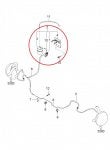As I have decided to change the grease of the wheel and halfshaft bearings I decided to document my work step by step, since it seems like a recurring topic of interest. So let's start! Till now, I did the removal, but I cannot guarantee that I will also document the reassembly.
First of all, safety. Working on cars is very dangerous, you risk your life, or serious impairment, or serious damage to the car and things, especially when working with the wheels off, and it is not just theory, it is a real danger, I personally faced a great risk too (once my car slipped from a mechanical jack while I was lowering it and the jack slipped under the car, just in one of the few empty spots under the car; seriously I could die). Always use the proper tools and avoid using tools in a manner different from that for which they were designed. However it still remains a dangerous job, so if you decide to do it, you do it at your own risk.
For safety reasons I put some concrete blocks under the front differential before removing the wheel
![Image]()
And I chock up the wheels
![Image]()
I hope that your chocks are better than mine, for now I have to settle with these ones; it is difficult to find strong and reliable wheel chocks at a resonable price over here. Then, one thing already told and retold, the car must be supported with a suitable jack stand.
After safety there is cleanliness
![Image]()
Keep your workplace as clean and tidy as possible. Hubs in particular are one of the dirtiest parts of cars and if you don't clean constantly you will soon find yourself in a bit of a chaotic situation and in a chaotic situation it is easier to cause accidents, as well as it makes your work more difficult and tiring.
Then there are tools. To work on hubs it is useful to have some special tools; these, in particular, are almost indispensable
![Image]()
They are a bearing puller and a circlip pliers set. Moreover, the hub is full of fat so it would be better to use some grease-resistant gloves, such as nitrile gloves, but you will see that, to accomplish the work, I will use various other not very common tools and products.
First of all, safety. Working on cars is very dangerous, you risk your life, or serious impairment, or serious damage to the car and things, especially when working with the wheels off, and it is not just theory, it is a real danger, I personally faced a great risk too (once my car slipped from a mechanical jack while I was lowering it and the jack slipped under the car, just in one of the few empty spots under the car; seriously I could die). Always use the proper tools and avoid using tools in a manner different from that for which they were designed. However it still remains a dangerous job, so if you decide to do it, you do it at your own risk.
For safety reasons I put some concrete blocks under the front differential before removing the wheel
And I chock up the wheels
I hope that your chocks are better than mine, for now I have to settle with these ones; it is difficult to find strong and reliable wheel chocks at a resonable price over here. Then, one thing already told and retold, the car must be supported with a suitable jack stand.
After safety there is cleanliness
Keep your workplace as clean and tidy as possible. Hubs in particular are one of the dirtiest parts of cars and if you don't clean constantly you will soon find yourself in a bit of a chaotic situation and in a chaotic situation it is easier to cause accidents, as well as it makes your work more difficult and tiring.
Then there are tools. To work on hubs it is useful to have some special tools; these, in particular, are almost indispensable
They are a bearing puller and a circlip pliers set. Moreover, the hub is full of fat so it would be better to use some grease-resistant gloves, such as nitrile gloves, but you will see that, to accomplish the work, I will use various other not very common tools and products.






